This is the winning theme of the poll at the bottom of the previous Blog post: beaches (won with a two-thirds majority!). Now, as I remarked below the poll, beach holidays are of course more or less the opposite of dark tourism, and I for one despise them. I was dragged along to beaches as a child and I put up with it, but as soon as I was old enough to choose my own travel destinations, beaches have never been much on my radar. That is: holiday beaches, beach resorts, that sort of thing. I’ve never been to the famous Copacabana, Bondi Beach or any of those beaches of Spain, Turkey and elsewhere that holidaymakers flock to in large numbers – and (hopefully) I never will have to go to them. The reason: beaches packed with people are an absolute horror for me. For example, to me this is what Hell on Earth looks like:
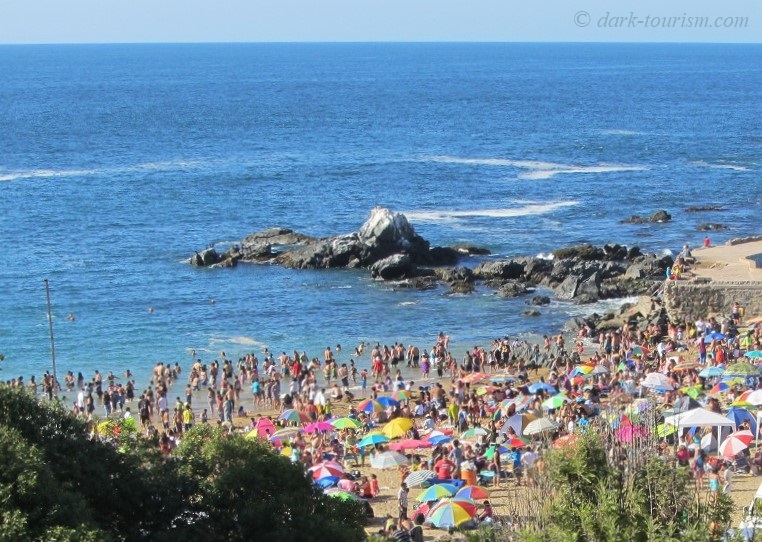
This was Playa Ancha in January 2012, and the photo was taken – from a safe distance with a telezoom lens – while I was on a (dark) tour of Valparaiso, Chile. Not 10,000 horses would have got me any closer to this ghastly beach scene. It’s more the crowds and associated activities/routines/clichés that so put me off, not so much beaches as such. For instance I can appreciate the look of a nice, empty beach such as this palm-lined one:
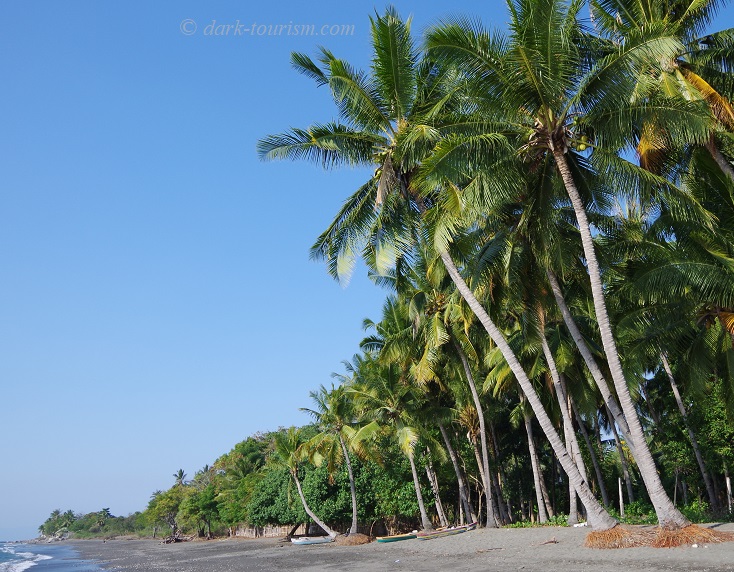
Looks nice and tropical – I concede. But what I still don’t like is the sand. I know that for many people walking barefoot on a sandy beach is sheer bliss – for me it’s horrific. The feeling of sand between naked toes … yuck, yuck yuck! No, I insist on keeping my shoes on when I – on one of those rare occasions – do find myself on a beach (my wife is different: she likes to go paddling on those occasions). I was on this beach in the above photo because it was near one of the places my wife and I had accommodation arranged during our tour of East Timor – and that tour obviously focused rather on the not so distant dark history of this island nation. But while the country provided plenty of dark-tourism incentives, this beach as such has no direct dark associations.
So let’s look for proper dark-tourism-destination beaches.
Probably the best-known ones would have to be the beaches of the D-Day landings in Normandy. And when I visited this part of France in 2016 the tour of associated sites that I went on included a couple of those beaches. This is Omaha Beach, one of the places where the US Army landed its troops on 6 June 1944:
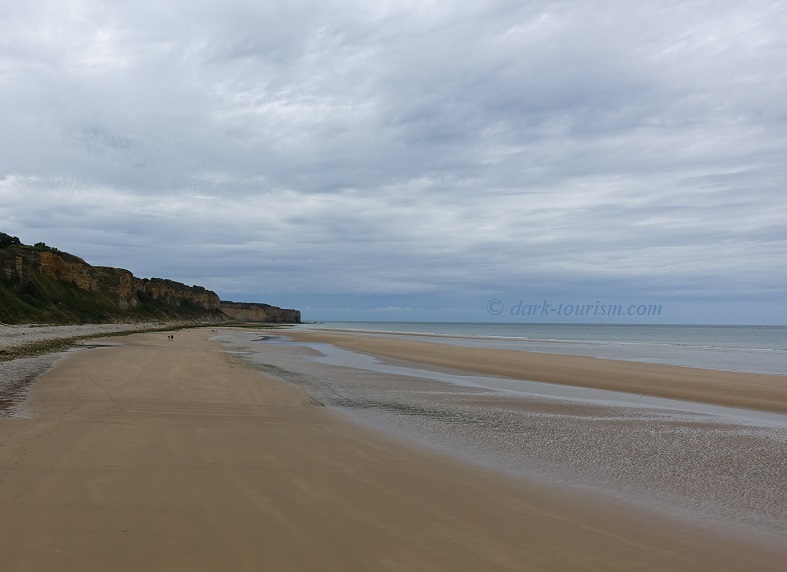
Today there are a few memorial monuments and a bit inland is a large American war cemetery and memorial hall.
A little further up the coast from Omaha the tour also included a good viewpoint of Gold Beach at Arromanches, where the British built an artificial harbour to support the landed forces. Remnants of this installation, called “Mulberry Harbour”, can still be seen prominently on this stretch of the coast:
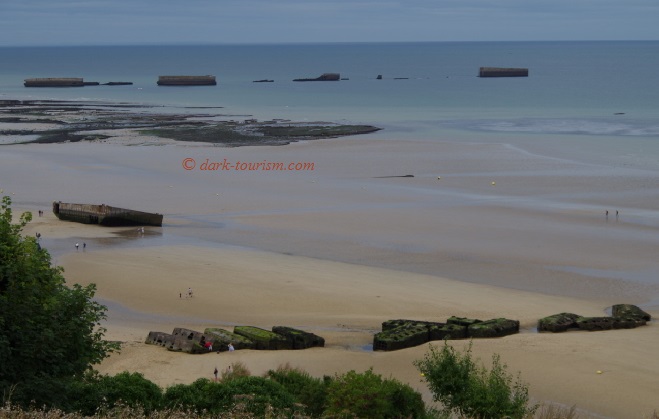
Another armed-conflict-associated beach I’ve seen quite recently was on Kinmen, Taiwan. That’s a group of islands far from the Taiwanese main island but only a few miles from the coast of mainland China. Up until well into the 1970s, the islands were regularly shelled by Chinese forces on the mainland, and the Taiwanese shelled back. Not only that, both sides also used to blast out propaganda messages across the strait from huge speaker stacks. The beaches on Kinmen where an amphibious landing could have been possible were reinforced by the Taiwanese with rows of spikes pointing diagonally towards the mainland as a measure to prevent such landings. Here’s an example:

One of the earlier battles of World War One that turned into utter carnage, with a total of ca. 130,000 soldiers killed between April 1915 and January 1916 was Gallipoli on the Turkish peninsula of the same name. And that was partly fought on beaches too. Here’s a photo of what the Allies named Brighton Beach, complete with a relic pillbox bunker slowly sinking into the sand:
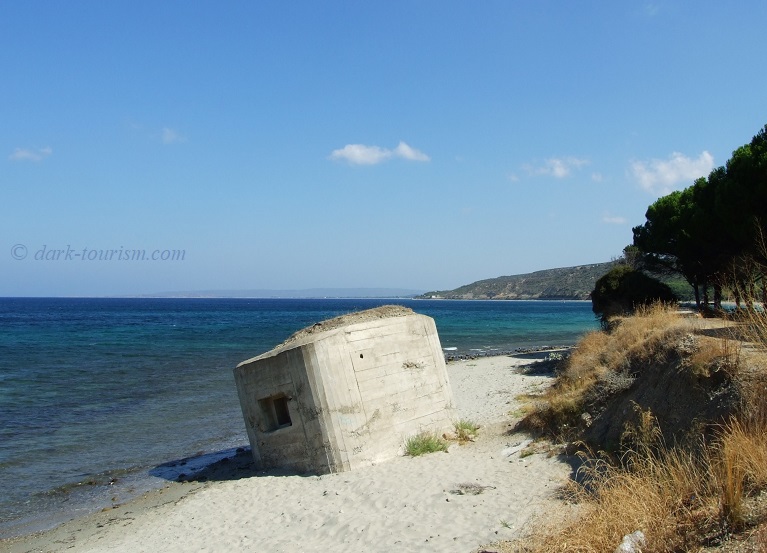
Back to WWII, but now the Pacific Theatre: next is a photo of a beach and cliffs at the southern end of Okinawa. These islands were the site of one of the largest and bloodiest battles that the USA fought against Imperial Japan, from April to June 1945. Not only did this battle, aka the “Typhoon of Steel”, claim countless military casualties, lots of civilians also lost their lives, in particular through suicide. The locals were indoctrinated by Japanese propaganda to believe that the Americans would rape, torture and enslave them so it would be more “honourable” to commit suicide instead of being captured. And thus many civilians chose to jump to their deaths from cliffs like these:
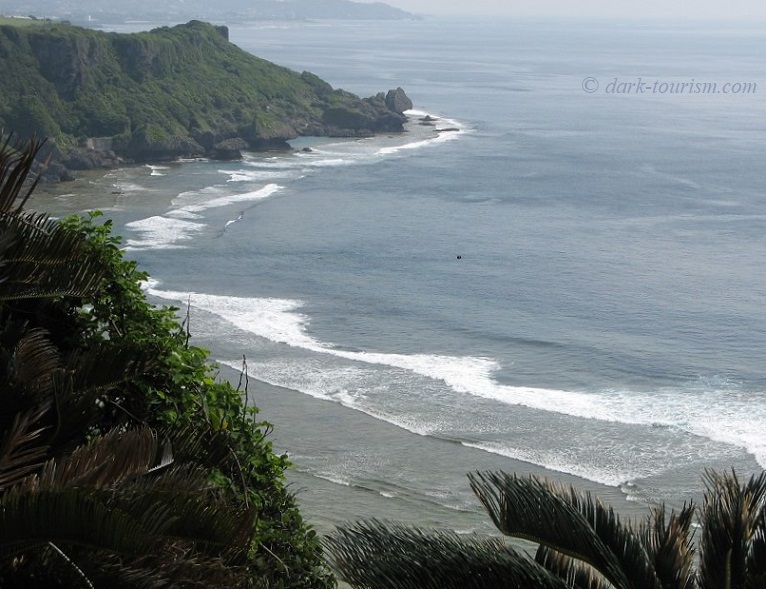
Leaving behind wars (please!), let’s move on to beaches that are dark for different reasons, such as through natural disasters. Enter Krakatoa – site of one of the largest and deadliest volcanic eruptions in recorded history. The explosion of the original Krakatoa in 1883 caused deadly tsunamis and the material ejected into the atmosphere by the eruption had global climatic consequences (a “volcanic winter”). Most of the original volcano disappeared in the explosion, but from 1927 a new volcano, named “Anak Krakatau” (‘child of Krakatoa’), rose from the Sunda Strait (the waters between Java and Sumatra) and has regularly erupted ever since. I visited this new Krakatoa in 2014 as part of my extensive trip to Indonesia and took this photo of a black beach in the foreground and a recent lava flow in the background:
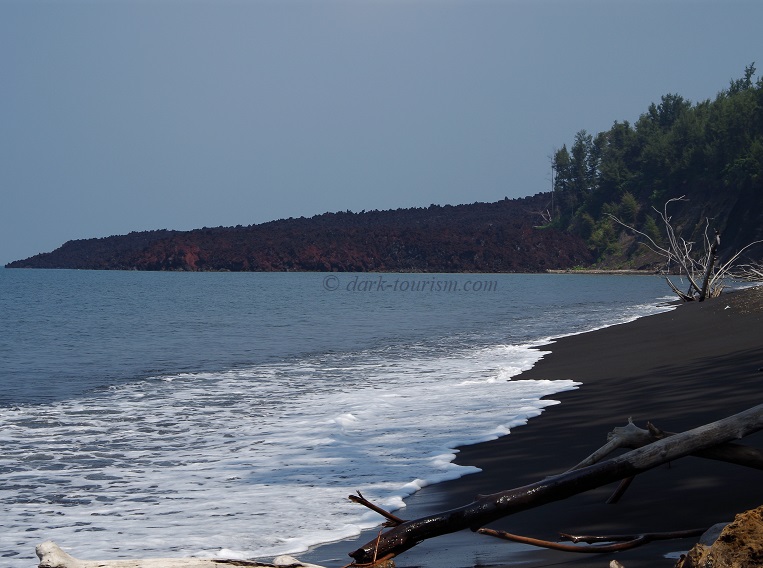
And this “child of Krakatoa” has proven unruly and deadly too: in December 2018, a partial collapse of one side of the volcano with a massive landslide falling into the larger Krakatoa caldera caused the most deadly tsunami the region has seen since 1883, with well over 400 people killed. So it remains very dark indeed!
More harmless looking is the vast black Dyrholaey Beach on the south coast of Iceland, photographed in August last year:
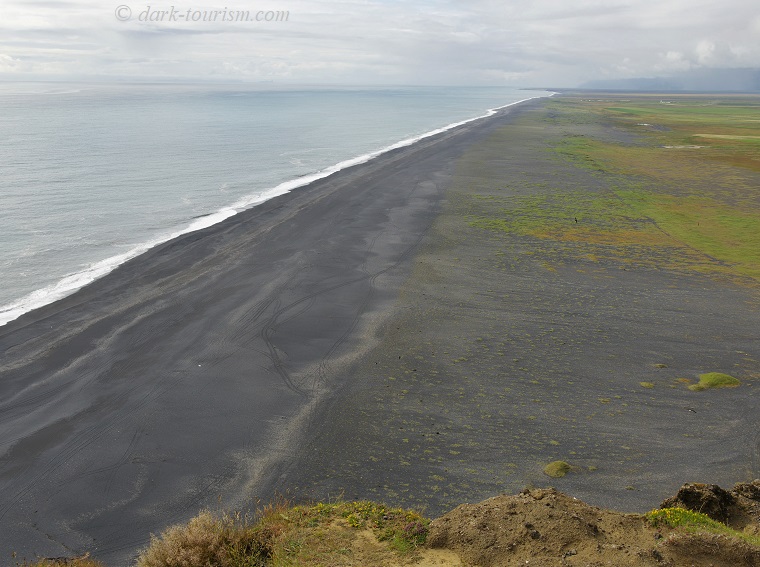
Black beaches are generally the result of volcanic activity, of which Iceland, too, has plenty. In this case the black sand has been washed down from the eruptions of volcanos further north, some under glaciers, e.g. the temperamental Katla (see Lava Show) or the delightfully difficult to pronounce Eyjafjallajökull, the one whose ash plumes caused a major disruption of the European airspace in 2010. This photo was taken from the Dyrholaey headland looking west. In the far background lies the black beach of the name Solheimasandur. Here one can find the wreck of a stranded C-47 Dakota plane – which unfortunately I was not able to see.
However, I spotted some shipwreck parts on yet another black beach, this time on the island of Heimaey, off the main island of Iceland:
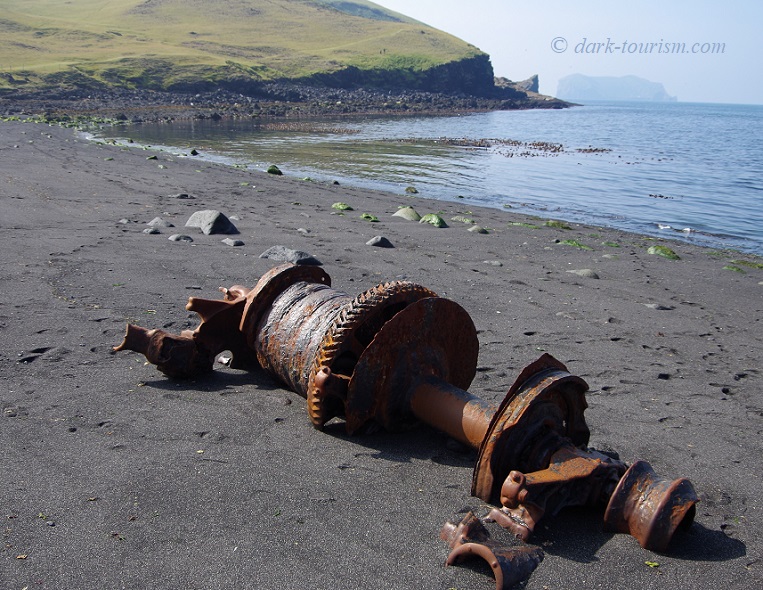
Of course, shipwrecks can give many a beach a dark association, and a particularly wreck-prone coast is that of Namibia. Here’s a photo of the wreck of a vessel called Shawnee, beached on a lonely desert coastal stretch, taken from aboard a scenic flight over the Namib Desert:
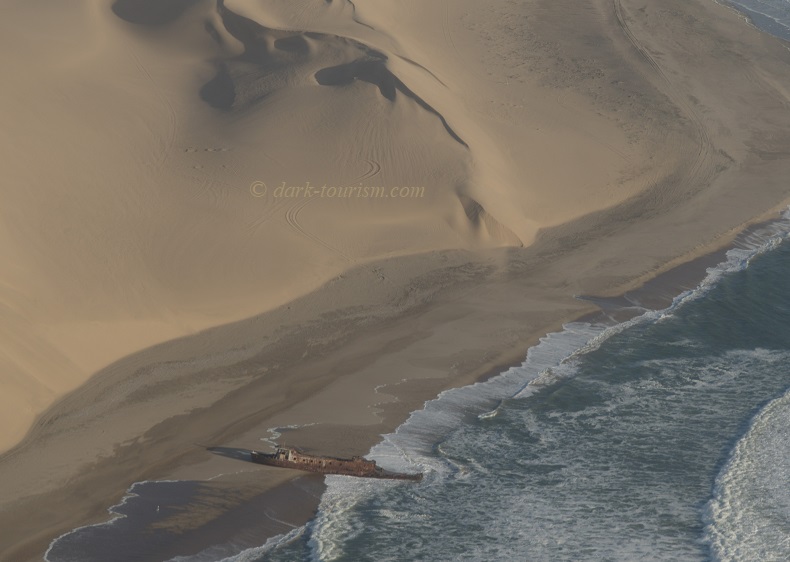
I saw another beached vessel on the lower stretch of what is aptly called the Skeleton Coast, due to its many shipwrecks. Most of these have largely eroded away and new wrecks rarely come about these days thanks to GPS navigation aids. But here is an exception, the Zeila shipwreck, a vessel that stranded relatively recently and is hence still pretty intact:
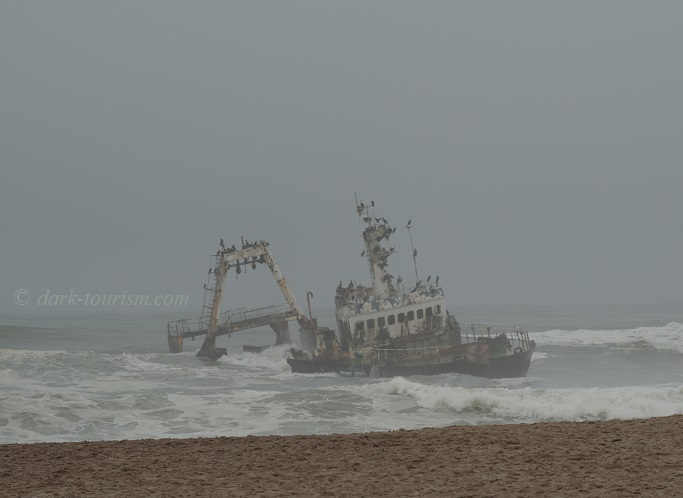
This was a decommissioned trawler that was actually being towed to India where it was to be broken up for scrap, but the towing line came off and the boat drifted towards the coast and stranded there. Nobody was harmed but the vessel is lost. Still, good news for the local population of cormorants who use it to perch safely out of reach of jackals and other predators.
Another sort of abandoned human-made structures that are a classic type of dark-tourism destination are ghost towns, and indeed one of the most fabled ghost towns on Earth is Varosha in Northern Cyprus. This was once a bustling beach resort town until it emptied as the Greek Cypriot inhabitants fled from the Turkish invasion of 1974. After that the place became totally off limits to the public and was guarded by the Turkish military. It was only in 2020 that parts of Varosha were opened up for tourists. And when I visited in January 2023, I found myself on this stretch of beach that was made accessible again, with the ruins of the abandoned hotels of the resort as a haunting backdrop (same photo as the featured one at the top of this post):
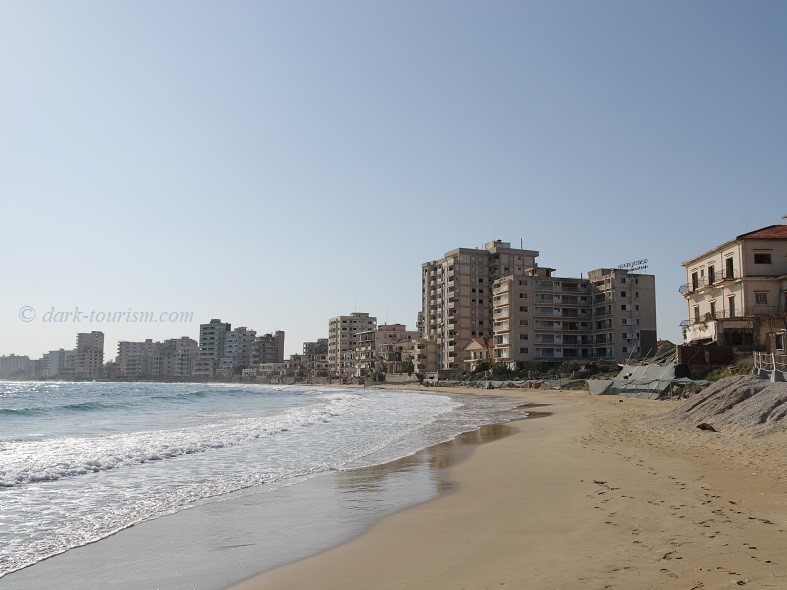
Also in Northern Cyprus, on the same trip, I indulged in a spot of industrial urbexing at an abandoned copper-loading jetty and surrounding industrial structures at Gemikonagi. The jetty extended well beyond the beach into the sea. Quite a stunning sight I thought:
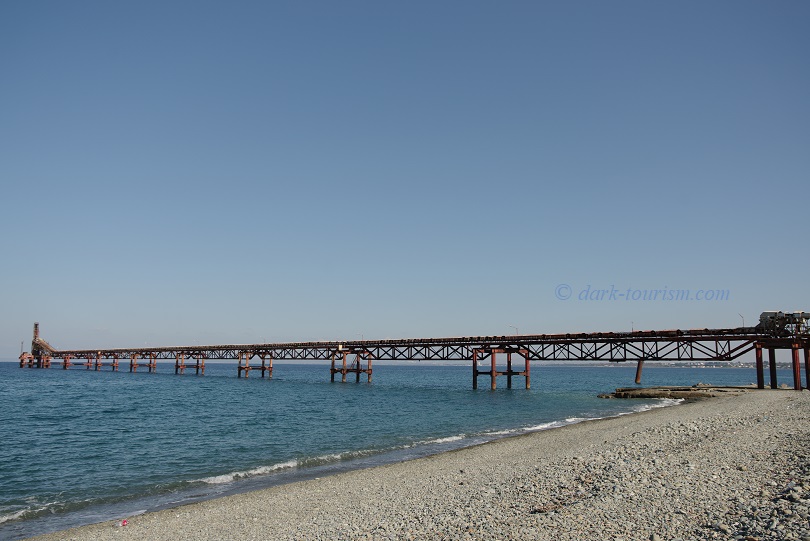
A single ruin of a house also right on a beach I found many years ago (in January 2007) in Yala National Park in southern Sri Lanka:
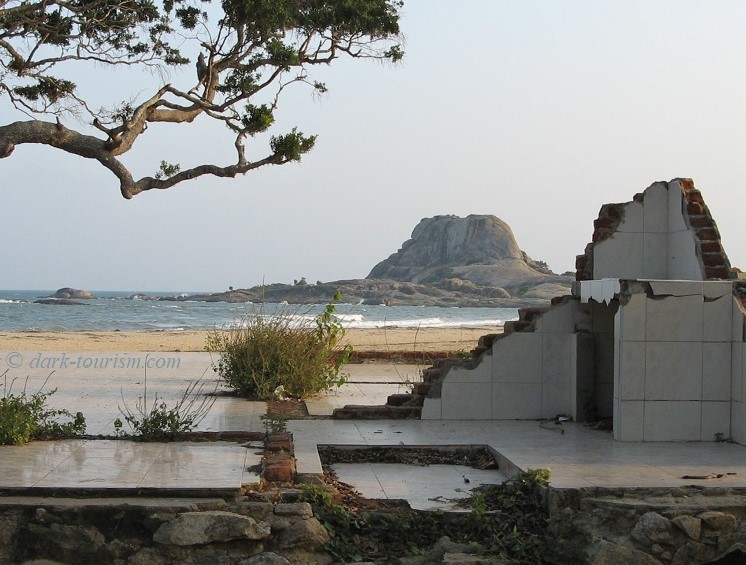
These are the remains of what was a guest house, and on the morning of 26 December 2004 some 60 people were swept away from here and killed by that day’s tsunami wave (including three who officially remain “missing”, i.e. whose bodies were never found); amongst these were 15 Japanese and German tourists. I’ve meanwhile been informed that the ruin and the adjacent memorial monument have deteriorated (or maybe have fallen victim to vandalism?) so that the place no longer looks like it does in this photo.
The same tsunami affected numerous other countries too, including southern India. In January 2017 my India trip included Tranquebar in the state of Tamil Nadu where I was given a tour by a local guide who pointed out how the tsunami had damaged the coastal town and indicated how high the water had reached. Here’s a photo of the coast and beach of Tranquebar – the 2004 tsunami wave would have reached as high as the stone wall you can make out in the top left corner of this photo:
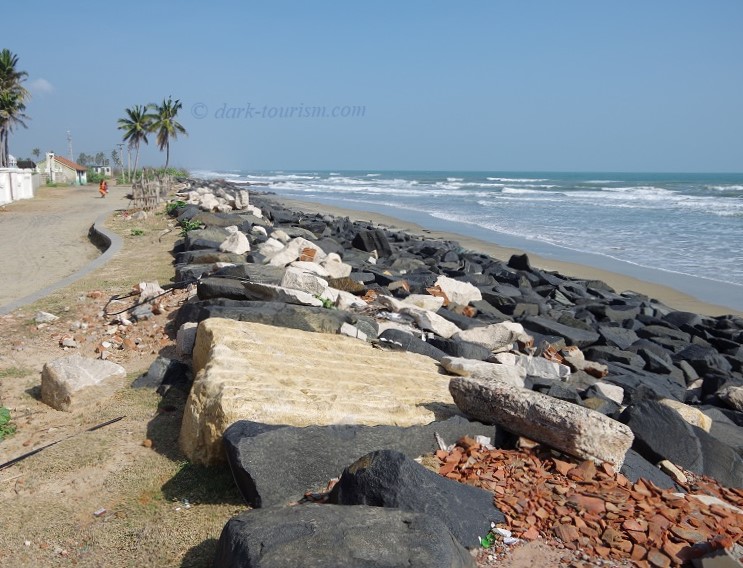
The region hit by far the worst by that tsunami was Banda Aceh in northern Sumatra, Indonesia. When I travelled there in July 2014, I was given a comprehensive tour of local tsunami-related sites, including the main museum, memorials, ruins of buildings and several boats stranded far inland. But at one point we also made a stop at a beach, where the locals were enjoying themselves Banda-Aceh-style … as there is strict Muslim Sharia law in place in Banda Aceh, women have to remain fully dressed and veiled, even if they do go into the water. Here’s a little impression:
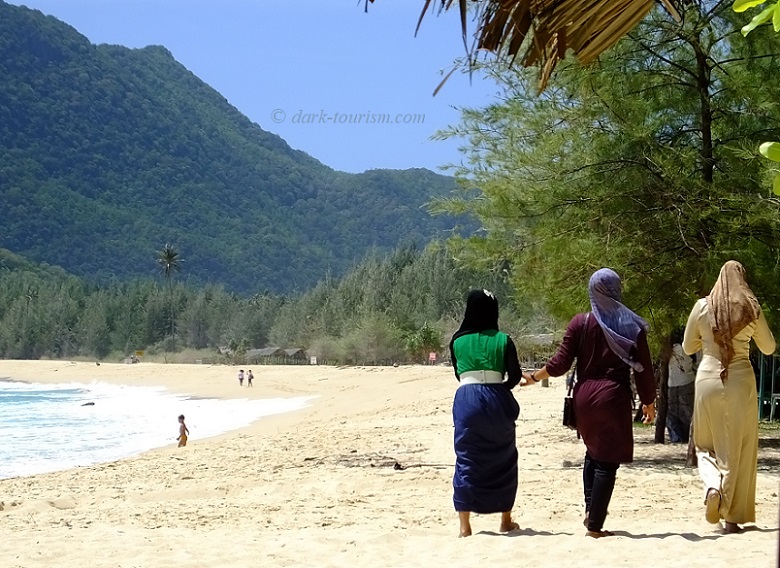
The exact opposite could have been witnessed on this next beach, grandly called “Sahara Beach” on the island of Rab in Croatia – as that’s a nudist beach! It’s apparently very popular with German tourists, and hence it’s marked “FKK” (which stands for “Freikörperkultur”, roughly translatable as ‘free/bare body culture’). Except when I was there it was early spring, well before the season would start, and so the beach was totally deserted:
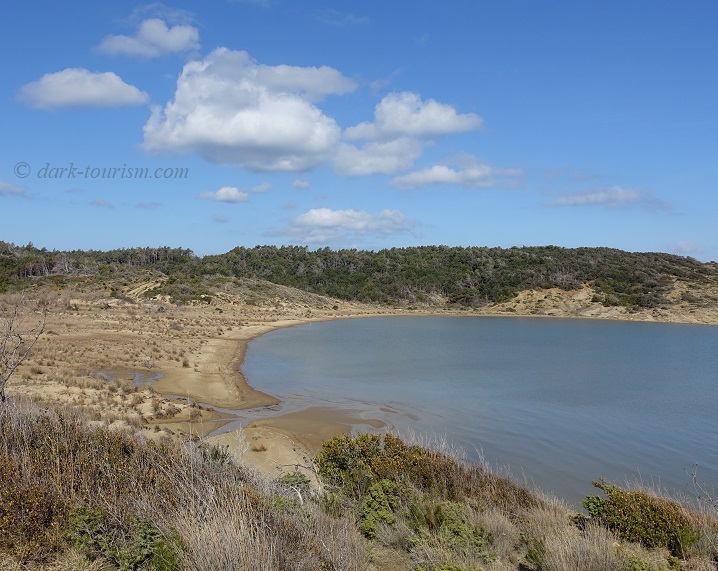
Of course I didn’t head to this beach for nudist swimming or sunbathing (see the opening paragraph of this post again!), let alone any voyeurism. No, I visited Rab primarily because it’s the jumping-off point for boats to the infamous Goli Otok, aka “Tito’s Alcatraz”, a former Yugoslav-era prison island right opposite this beach and well visible from there. So what makes this beach ‘dark’ is more its association with another site nearby.
In the African nation of Senegal, I was on another beach, namely on the small island of Goree in the bay of the capital city Dakar:
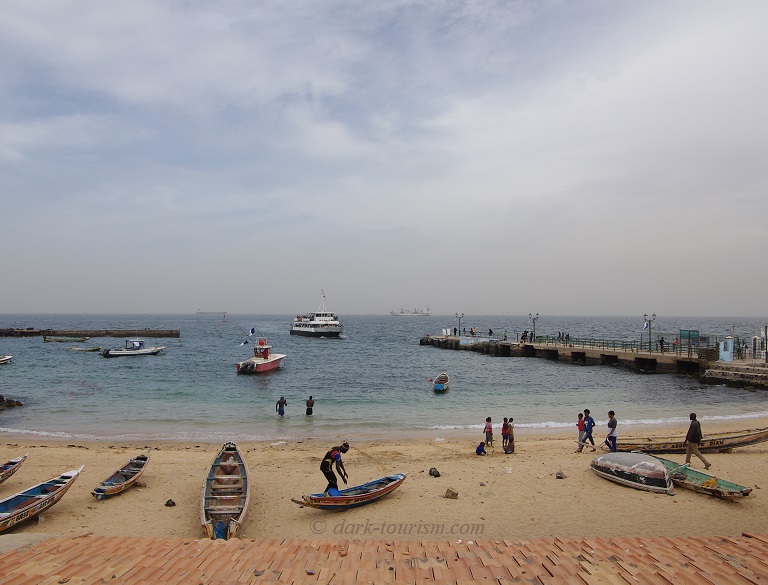
The reason I visited this place was because Goree was a collection- and departure point in the Transatlantic slave trade of the 16th to 19th centuries. The slaves-to-be were incarcerated in the island’s fort and “dispatched” from there to be traded as slaves in the Americas. Today the fort is a museum known as Maison des Esclaves.
Finally, let’s go back to the southern hemisphere, but this time to a particular dark-tourism destination: the Falkland Islands. Of course I travelled there (a year after Cape Verde/Senegal) for the relics and commodification of the Falklands War of 1982 between Argentina and Great Britain. Most of the battlefield sites are located inland, but I also found myself on various beaches, though mainly for wildlife watching: elephant seals, sea lions and especially penguins galore. The only slightly dark element was watching this vulture tucking into some carcass (possibly an ex-sheep) on a beach near Port Howard:
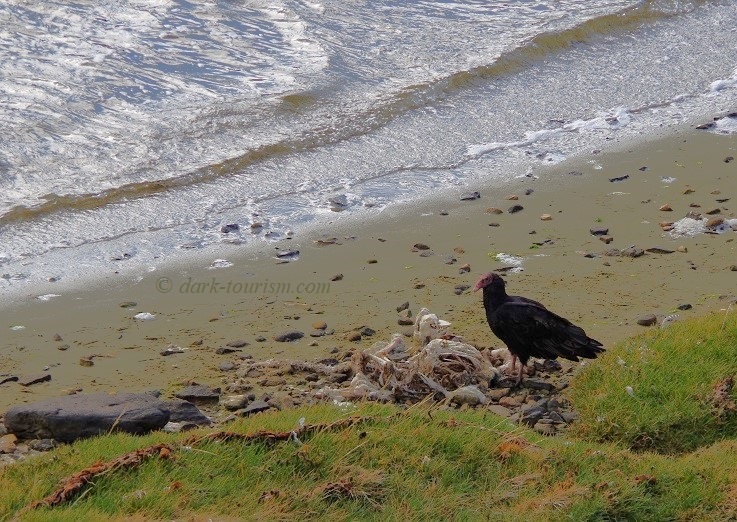
And that concludes this themed post of DT & Beaches. I hope you found it interesting.
Composing themed posts again after all this time (see previous Blog post) has been quite fun, and since I still can’t resume work on my main website (as that is undergoing technical maintenance and updates) I’ve decided to follow up this post with another poll on Blog themes. The theme that came second last time (bullet holes), I’m fielding again to give it another chance, plus three new ones:
a) DT & bullet holes
b) DT & planes
c) DT & stairs
c) DT & graffiti
As before, either put your choice in a comment below this post, or if you are a subscriber to the DT Newsletter, you can also let me know in private by replying to the next Newsletter issue that will be sent out as soon as this post is uploaded (and if you’re not a subscriber yet you can sign up in the top right-hand corner of this post).
This time “stairs” is perhaps the least obvious theme suggested here, and with regard to “planes” I have to point out that I mean (more or less) intact planes and not plane wrecks or plane crash sites (that’s a separate theme for another time). The “graffiti” theme has the potential for containing strong language (certainly the “F-word”) so if that puts you off choose something else … and should the theme win anyway maybe don’t go there 😉 “DT & Bullet Holes” should be pretty self-explanatory …
—————-
UPDATE 8 June 2024: this poll is now closed – and the winning theme (bullet holes) uploaded
—————–




30 responses
DT & Planes
noted!
DT & graffiti
noted!
What wonderful post! I thoroughly enjoyed DT and beaches! Thank you. OK…. one vote for bullet holes!
thanks – and vote noted!
Wahnsinnig interessanter Bericht, vielen Dank!
Ich bin für die Einschusslöcher, liebe Grüße Anya
OK!
DT&Planes, obviously 😉
😉
DT & Bullet Holes
noted!
DT and Bullets please
of course, again … noted!
DT & Graffiti please
noted!
It’s DT & bullet holes for me!
noted!
Loved the article on beaches!
DT & Bullets please Peter
thanks! I enjoyed composing it too. Your note’s been noted.
Sounds like a most interesting read:
a) DT & Bullet Holes
Thank you for allowing the input.
yes, it’s nice to have a bit more interaction again. Your vote’s been noted.
Hi Peter, DT & Stairs for me but it looks like I am the only one so far!
noted! There seems to be a strong tendency here in the comments, yes – but there are also the private votes by Newsletter replies …
Going for DT + Planes – thanks!
noted!
DT & Graffiti please. S x
noted!
Graffiti!
noted!